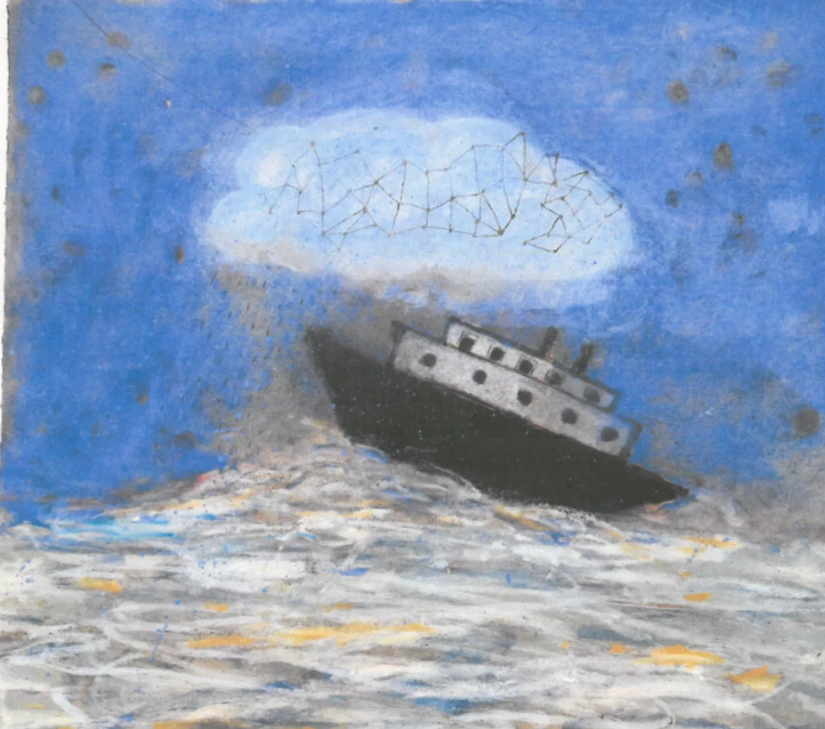
Squeak Carnwath is an artist whose work transcends traditional boundaries, blending abstraction with deeply personal narratives and reflections on human experience. Her work often brings together complex layers of color, texture, and form that invite viewers to engage on both intellectual and emotional levels. One of her recent pieces, Cloud Map (2024), exemplifies her mastery of abstraction, merging elements of visual storytelling with an exploration of nature, memory, and perception.
In Cloud Map, Carnwath explores the concept of mapping—both a literal and metaphorical act. The title of the work immediately evokes a sense of exploration and geography, suggesting that the piece might contain a kind of topography, perhaps representing the mind or an imagined landscape. Carnwath is known for her use of mapping and cartography as a method to represent how we navigate and make sense of the world. In this work, the mapping is not of physical terrain but rather a reflection of the internal and ephemeral nature of thought and existence, an attempt to trace the clouded, intangible paths that define our personal and collective experiences.
The piece is part of a larger body of work that deals with the theme of how individuals perceive and internalize the world around them. Carnwath’s use of clouds in the title hints at this ephemeral, ever-changing quality. Clouds, after all, are not permanent; they shift and dissolve, making them a fitting metaphor for memory, time, and perception. Through the act of painting, Carnwath attempts to “map” the shifting nature of these elements in a way that is both precise and fluid.
At first glance, Cloud Map presents a visual landscape filled with bold, expressive brushstrokes and a striking palette that oscillates between vibrant hues and muted tones. Carnwath often uses color as a powerful narrative tool, and in this case, the colors evoke a sense of both optimism and melancholy. The yellows, blues, and pinks might be interpreted as fleeting moments of clarity, flashes of insight, or perhaps remnants of past emotions. The chaotic yet deliberate arrangement of forms and colors suggests the way our minds work—fragmented, layered, and sometimes disjointed.
However, the fluidity of the piece is tempered by its structure. Despite the softness of the cloud imagery, there is a sense of order and intention behind the work. The shapes and lines seem to guide the viewer’s eye across the canvas, establishing a connection between the abstract forms and the personal interpretations they might invite. In this way, Cloud Map is not just an exploration of external landscapes, but also a representation of the internal process of making meaning. The viewer is asked to navigate through the clouds, to trace the lines of thought that move across the canvas, and perhaps to find their own reflections within the piece.
One of the most striking elements of Cloud Map is Carnwath’s use of texture. The surface of the painting is rich and tactile, with layers of paint that suggest both depth and movement. In some areas, the paint is applied thickly, almost like a relief, inviting the viewer to physically engage with the surface. In others, the paint is more delicate and translucent, adding to the sense of lightness and fluidity that the cloud imagery suggests. The texture not only contributes to the visual interest of the piece, but it also reinforces the theme of flux and transformation. Just as clouds are constantly shifting, the texture of the painting itself seems to shift depending on the angle from which it is viewed.
In her practice, Carnwath often integrates symbolic elements that reflect her personal experiences. The clouds in Cloud Map may not just represent the transient nature of thought, but could also allude to broader themes of memory and loss. Clouds can symbolize something elusive—perhaps a dream, a fleeting moment, or a memory that is just beyond reach. In this sense, the piece may be a meditation on the passage of time, on how we attempt to hold onto memories and experiences that are inevitably ephemeral. The layers of color and texture could suggest the accumulation of memory, which grows denser and more complex over time, even as it fades and dissolves.
Carnwath’s approach to abstraction is also notable in this work. While her compositions may appear chaotic or fragmented at first, closer examination reveals a careful balance between randomness and intention. This duality reflects the complexity of human thought and emotion—how we might experience a flurry of disjointed sensations or ideas, but still manage to impose meaning or coherence on them. The tension between chaos and order in Cloud Map could thus be read as a visual metaphor for the mind’s attempt to make sense of the world, even when the world itself feels unpredictable or uncontrollable.
The idea of mapping in Cloud Map is not merely about cartography in the traditional sense; it also delves into the idea of “mapping” internal states of being. The cloud, as a symbol, has long been used in literature and art to represent the ungraspable or the fleeting. It is a subject that can’t be fully contained or pinned down, much like the shifting terrain of personal memory or emotional experience. Carnwath’s painting thus invites us to reflect on how we navigate these intangible aspects of existence. The act of mapping becomes both an attempt to understand and an acknowledgment that some aspects of life—like clouds—are beyond full comprehension.
Furthermore, the work’s title—Cloud Map—also suggests a form of navigation, as if the viewer is being asked to chart their own course through the clouds. The piece is both an invitation to engage with the landscape of the mind and a reminder that such engagement is subjective, personal, and never entirely fixed. This aspect of the work aligns with Carnwath’s broader exploration of the complexity of human perception and experience.
Cloud Map (2024) is a deeply reflective and visually captivating work that embodies Squeak Carnwath’s ongoing exploration of memory, perception, and the passage of time. Through the metaphor of clouds, she navigates the internal landscapes of the mind, suggesting both the clarity and the elusiveness of thought. The rich textures and vibrant colors invite the viewer to connect emotionally with the piece, while the layered abstraction encourages a deeper intellectual engagement. Ultimately, Cloud Map serves as both a visual and conceptual journey, one that reflects the constant ebb and flow of human consciousness and the maps we create to make sense of our experiences.
No comments yet.








